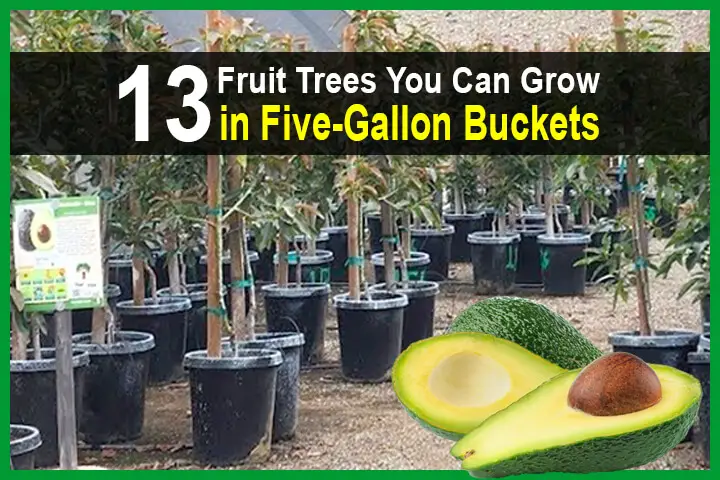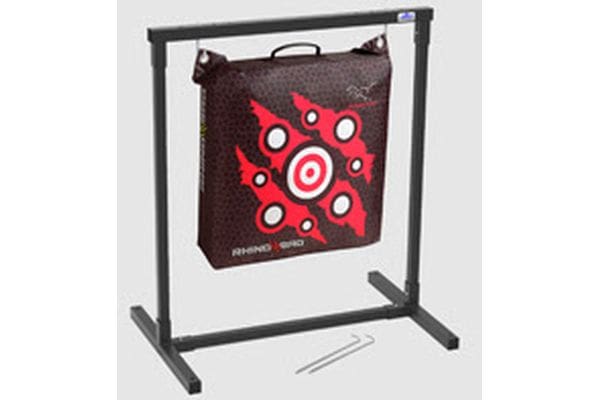Estimated reading time: 12 minutes

Did you know there are fruit trees that can grow in five-gallon buckets? Unfortunately, fruit trees can be a bit complicated to grow because of their need for space, sunshine, pollination, and water. As a result, some people are hesitant to even try to grow fruit trees because they can also be an expensive investment.
However, if you have some five-gallon buckets, you can grow some pretty amazing fruit trees! In this article, we’ll take a look at 13 fruit trees to grow in five-gallon buckets and give you some tips on how to help them grow.
Want to save this post for later? Click Here to Pin It On Pinterest!
What types of trees can you grow in five-gallon buckets?
First of all, you can start just about any fruit tree in a five-gallon bucket. In fact, you’ll find that when you purchase a fruit tree from a nursery, it will typically come in a container that is about several gallons in size. Large fruit trees can be slow-growing, so you can keep pretty much any fruit tree in a five-gallon bucket for a couple of years before you need to transplant it.
On the other hand, if you want to keep your fruit trees in five-gallon buckets, you’ll want to look for dwarf varieties. Dwarf varieties of fruit trees are hardy trees that have been grafted onto rootstock. These trees typically only reach sizes of 8 to 10 feet tall, but they bear full-size fruit.
Dwarf fruit trees may even reach maturity faster than their full-size counterparts. You can prune them just like a full-size tree to keep them to a very manageable size, whether you are growing them in a small yard or a container.
Do You Need Special Buckets?
No, you can use any clean five-gallon bucket (as long as it didn’t have any chemicals in it). However, you’ll want to prepare the bucket for the tree. You’ll want to drill a few holes in the bottom and even the sides of the bucket so that excess water can drain out. Drainage holes will help to prevent root rot.
You can purchase inexpensive buckets at Home Depot or use food-grade buckets from bakeries, or you can buy them online. Either way, as long as they are clean, just about any five-gallon bucket will work.
The Best Fruit Trees to Grow in Five Gallon Buckets
Avocado Trees

Avocado trees are a lot of fun to grow. You can take any avocado from the grocery store and try to plant its seed. Then, all you need to do is stick the seed in damp soil. Keep the soil damp until it sprouts – this could take months, so don’t worry if it doesn’t happen right away.
You can easily grow your avocado tree in a five-gallon bucket for a long time. You can even prune them to control the size. However, they are unlikely to flower or fruit indoors. In addition, these tropical trees aren’t cold hardy, so they won’t survive a harsh winter.
So it isn’t necessarily practical to plant and grow avocados in five-gallon buckets, but you certainly can try! And you might just get lucky and get a few delicious avocados out of it.
Cherry Trees

You can grow cherry trees in containers, too. First, you’ll want to find a self-pollinating dwarf cherry tree. If you can’t find a self-pollinating tree, you’ll need to plant multiple trees.
Make sure the rootball of your cherry tree is smaller than the bucket. First, plant the tree with loose, well-draining soil. Then mulch the top of the bucket to keep the moisture in. In time, you will probably need to plant the cherry tree into a larger pot or plant it in the garden.
For example, Stella is a self-fertilizing variety of cherry tree that grows in USDA hardiness zones 5 through 8. So if your tree outgrows its bucket, you can probably plant it outside. You’ll need to keep it well-watered while it fruits.
Some varieties of cherry tree are sweet (like the cherries you buy at the grocery store), and others are sour (like you would use for pies). Tart cherries are hardier and easier to grow than sweet ones.
Dwarf Apple Trees

Apple trees can be grafted onto dwarf rootstock. You can grow them easily in a five-gallon container as long as you choose the right variety and keep it well pruned.
For example, Scarlet Sentinal columnar Apple trees are a specific variety that doesn’t spread out wide, so they are perfect for containers and tight spaces.
However, apple trees need to be cross-pollinated, so choose the golden sentinel columnar apple as its partner. They need full sun and 400 chill hours. However, these little trees will probably produce their first season.
Dwarf Lime Trees
Dwarf lime trees, such as the ‘Bearss Seedless Lime’, are perfect for growing in containers. These trees can thrive in five-gallon buckets due to their compact size and relatively low maintenance needs.
Dwarf lime trees prefer sunny locations and well-draining soil to prevent root rot. Regular watering and occasional fertilization will help produce a bountiful lime harvest. These trees also make attractive indoor plants during colder months, provided they get enough light.
Dwarf Nectarine Trees

Nectarines, closely related to peaches, can also thrive in five-gallon buckets. The dwarf nectarine variety ‘Nectar Babe’ is a great choice for container gardening. It remains under 5 feet tall, making it easy to manage and perfect for small spaces.
Make sure your nectarine tree gets plenty of sunlight and prune annually to promote health and fruit production. These trees enjoy warm climates and can be moved indoors in regions with harsh winters.
Dwarf Orange Trees

Typical orange trees need a hot climate to grow, but you can grow dwarf orange trees in containers just about anywhere. Trovita orange trees are easy to grow indoors, but they can reach a height of ten feet, so you may eventually need to transplant them into a larger container.
You’ll want to put a little bit of gravel in the bottom of your bucket to help with drainage. Then add loose and lightweight potting soil to the bucket and plant your tree. You can put them outdoors in the summer. Just make sure to keep them watered and fertilized, whether they are indoors or outdoors.
Dwarf Peach Trees

These little trees don’t get too tall, although they do fan out and take up space. Dwarf peach trees are self-fertilizing, although they will benefit from cross-pollination.
Contender is a variety of peach tree that only reaches 15 feet tall. They are pretty cold-hardy as well, although most other types are not. You’ll have to bring them inside to protect them from frost.
This variety is good for fresh eating, freezing, and canning. Fertilize these trees in early spring. Keep in mind that these peach trees could take two to four years to bear fruit.
Dwarf Pear Tree

Dwarf pear trees, like the ‘Garden Belle’ or ‘Garden Gem’, are perfect for bucket gardening. These trees are grafted onto special rootstock that keeps them compact, usually not growing taller than 6 to 7 feet.
Put them in a sunny spot and use well-draining soil to prevent waterlogging. Dwarf pear trees are productive and can yield a considerable amount of pears even in a bucket. They require some winter chill but are versatile enough for various climates.
Fig Trees

Fig Trees need lots of full sun, so they can be challenging to grow indoors. But you can grow them in pots and move them outside for the summer. Then keep them in a cool, dry place for the winter. They do get large and can be difficult to move.
However, Petite Negra is a variety of fig that grows very well in containers indoors. It produces full-size fruit even though the tree itself only grows from 3 to 8 feet tall. Keep your fig tree in a south-facing window that gets lots of sun. It will probably need to be watered every day.
Petite Negra will likely keep its leaves all year round, but other varieties of figs may drop their leaves and need to go dormant for winter. If that’s the case, just keep them in an unheated room indoors, so they don’t freeze. Then, when the danger of frost has passed in the spring, you can put them outdoors again.
Lemon Trees

Dwarf Meyer Lemon is a variety of lemon tree that does very well in containers. However, they don’t get as large as other types of lemon trees.
Lemon trees need good drainage and consistent watering, so they don’t lose their leaves. In addition, they like high humidity and slow-release fertilizer. Finally, you’ll need to bring your lemon tree indoors to protect it from frost.
Miniature Blueberry Bushes

While not technically a tree, miniature blueberry bushes are an excellent addition to a fruit tree bucket garden. Varieties like ‘Top Hat’ and ‘Jelly Bean’ are bred for container life, staying compact and manageable.
Blueberries require acidic soil, they need around 6 hours of full sun, and they need regular watering. With the right care, they’ll produce plenty of berries every year.
Pomegranate

Dwarf Pomegranates, such as the Nana variety, are perfect for container gardening. You can easily prune them back to keep them under two feet tall, but they typically only grow to about three feet.
They grow small edible fruits that are also appealing to look at! In addition, they can tolerate being root-bound and periods of dryness, making them perfect for growing indoors.
They don’t like the cold, so if you put them outside in the summer, you’ll need to bring them in when it gets below 40 degrees Fahrenheit.
Ponderosa Lemon Trees
These are a cross between a lemon tree and a citron. They don’t look like your typical lemon tree, but you can grow them in a container. They need good drainage and frequent watering. You can prune them heavily to control their size, but make sure you do it early in the spring before they begin to bud.
If you want ponderosa fruit, you’ll probably need to hand pollinate them. The fruit should develop within 6 to 9 months of pollination. Unfortunately, these trees are not frost-hardy, so you’ll need to bring them inside when it starts to get cold.
Final Thoughts on Growing Fruit Trees in Five Gallon Buckets
Fruit trees can sometimes be challenging to grow indoors and in containers – but it can be done. Remember that you will need to use dwarf varieties of your fruit trees. You may need more than one tree to get the proper pollination.
Most fruit trees need good draining soil, frequent watering, and an appropriate fertilizer. If this sounds complicated, just ask at your local garden center or plant nursery. They can help you choose the best variety for your location and your container.
Like this post? Don’t Forget to Pin It On Pinterest!
You May Also Like:
Read the full article here




